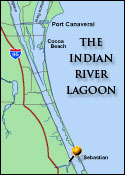The
Sebastian River, continued


An Anhinga airs it's wings
while perched high on the mast of a sailboat.
|
A sunk boat on a
sandbar of one of the spoil islands. The Indian River
is very shallow - usually only about 3 feet deep - except
for one deep channel dug down the middle. The sand that
was dredged up to dig the channel was piled up into what
are called "spoil islands". They don't even
have names, just "Spoil Island No. 1", "Spoil
Island No. 2", etc.
<<< SideNote: old
Indian River joke: man fell overboard and was thrashing
and splashing and screaming "Save me! Save me!".
Passing boaters yelled back "Put your feet down!".
The Indian River is quite shallow - my brother used to
walk across it (except for that deep channel). >>>
Fast growing trees like
Australian Pine and Brazillian Pepper grow up on the islands,
holding them together and giving visitors some welcome
shade.
Lots of pelicans, osprey,
eagles, herons and other birds nest in the spoil islands,
and manatee and dolphins swim around them.
 
We were delighted
to see a pod of dolphin swimming around our boat. Our
guide told us that there are several individuals among
them who are regulars in the lagoon.
 
Larger boats speed
past us in the channel, but our pontoon boat rode the
wakes out very smoothly. The lagoon has long been
a primary route for transportation, trade and supplies
along the east coast.
Unfriendly Indians,
mosquitos and swampland have kept down the population of
settlers over the years, but it couldn't last forever.
Now you have to be rich to afford to live along the waterfront. 
The bridge over the Sebastian
Inlet, one of several points where the Atlantic feeds
into the lagoon.
next
page.... |



